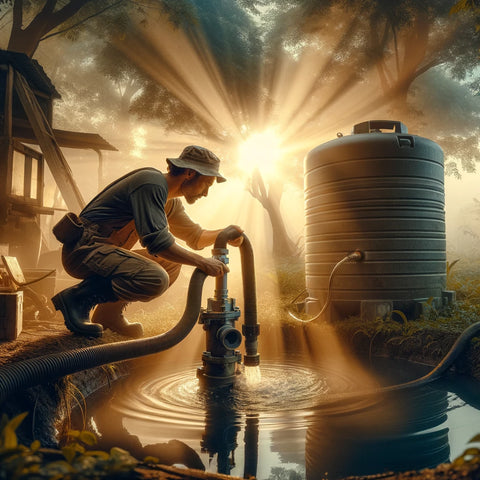Are you planning to set up a water system for your home, garden, or farm? Connecting a water pump to a water tank might sound daunting, but it's a crucial step for efficient water management. This guide simplifies the process, ensuring you can achieve a reliable setup, enhancing water accessibility for various needs.
Understanding the Components

Water Pumps: These devices move water from one place to another. Depending on your requirement, you can choose from submersible pumps (great for deep sources) or surface pumps (ideal for shallow sources).
Water Tanks: Tanks store water for later use. They come in different sizes and materials, suitable for indoor or outdoor use.
Pipes and Fittings: The conduits that connect your pump to your tank. The right size and material (PVC, metal, etc.) are vital for a leak-free system.
Tools and Materials Needed
Before you start, gather these essentials:
- Pipes (sized according to your pump and tank ports)
- Fittings (elbows, tees, adapters)
- Pipe wrench
- Teflon tape (for sealing threads)
- PVC glue (if using PVC pipes)
Step-by-Step Connection Guide

- Planning Your Setup: Identify the best locations for your pump and tank. Consider proximity and elevation to ensure efficient water flow.
- Preparing the Pump and Tank: Clean the inlet and outlet ports. Position your tank and pump securely, minimizing distance and elevation change.
- Measuring and Cutting Pipes: Measure the distance between the pump and tank. Cut your pipes accordingly, allowing a bit extra for secure fittings.
- Connecting Pipes and Fittings: Attach the pipes to your pump and tank using the fittings. Apply Teflon tape on threads to prevent leaks. If using PVC pipes, apply PVC glue for a secure bond.
- Sealing Connections: Double-check all connections. Tighten where necessary and ensure everything is sealed and leak-proof.
Priming the Pump
Before starting your pump, fill it with water. This step, known as priming, is crucial for the pump to begin moving water efficiently. Without priming, your pump might run dry, leading to damage.
Testing and Troubleshooting
Turn on your pump and watch the water flow. Check for leaks or drops in pressure. If problems arise, re-check your connections and seals. Sometimes, air trapped in the system can cause issues, requiring additional priming.
Maintenance Tips
To keep your system running smoothly:
- Regularly inspect pipes and connections for leaks.
- Clean your tank annually to prevent sediment build-up.
- Check your pump's operation, listening for unusual noises that might indicate a problem.
Connecting a water pump to a water tank can provide you with a reliable water supply for various applications. By following this guide, you're equipped to create an efficient water system tailored to your needs.
Whether you're irrigating a garden, supplying water to your home, or managing water for agricultural use, the right setup ensures you have water when and where you need it.
Equip yourself with the knowledge and tools to ensure a seamless and efficient water flow for all your requirements. And if you're ready to find the perfect water pump for your specific needs, check out our diverse collection.
With a bit of planning, the right tools, and a careful approach to installation, you'll establish a water management system that serves you for years to come.

